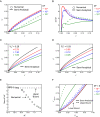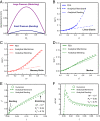Modeling programmable drug delivery in bioelectronics with electrochemical actuation
- PMID: 33836613
- PMCID: PMC7980470
- DOI: 10.1073/pnas.2026405118
Modeling programmable drug delivery in bioelectronics with electrochemical actuation
Abstract
Drug delivery systems featuring electrochemical actuation represent an emerging class of biomedical technology with programmable volume/flowrate capabilities for localized delivery. Recent work establishes applications in neuroscience experiments involving small animals in the context of pharmacological response. However, for programmable delivery, the available flowrate control and delivery time models fail to consider key variables of the drug delivery system--microfluidic resistance and membrane stiffness. Here we establish an analytical model that accounts for the missing variables and provides a scalable understanding of each variable influence in the physics of delivery process (i.e., maximum flowrate, delivery time). This analytical model accounts for the key parameters--initial environmental pressure, initial volume, microfluidic resistance, flexible membrane, current, and temperature--to control the delivery and bypasses numerical simulations allowing faster system optimization for different in vivo experiments. We show that the delivery process is controlled by three nondimensional parameters, and the volume/flowrate results from the proposed analytical model agree with the numerical results and experiments. These results have relevance to the many emerging applications of programmable delivery in clinical studies within the neuroscience and broader biomedical communities.
Keywords: analytical model; drug delivery; electrochemical actuation; flexible membrane; mechanics.
Conflict of interest statement
The authors declare no competing interest.
Figures




Similar articles
-
Analytical Modeling of Flowrate and Its Maxima in Electrochemical Bioelectronics with Drug Delivery Capabilities.Research (Wash D C). 2022 Mar 4;2022:9805932. doi: 10.34133/2022/9805932. eCollection 2022. Research (Wash D C). 2022. PMID: 35316891 Free PMC article.
-
A nanoliter resolution implantable micropump for murine inner ear drug delivery.J Control Release. 2019 Mar 28;298:27-37. doi: 10.1016/j.jconrel.2019.01.032. Epub 2019 Jan 25. J Control Release. 2019. PMID: 30690105 Free PMC article.
-
An electrochemically driven poly(dimethylsiloxane) microfluidic actuator: oxygen sensing and programmable flows and pH gradients.Lab Chip. 2005 Jun;5(6):634-45. doi: 10.1039/b416671j. Epub 2005 May 9. Lab Chip. 2005. PMID: 15915256
-
Engineering and evaluating drug delivery particles in microfluidic devices.J Control Release. 2014 Sep 28;190:139-49. doi: 10.1016/j.jconrel.2014.04.030. Epub 2014 Apr 30. J Control Release. 2014. PMID: 24794898 Review.
-
Small-scale systems for in vivo drug delivery.Nat Biotechnol. 2003 Oct;21(10):1184-91. doi: 10.1038/nbt876. Nat Biotechnol. 2003. PMID: 14520404 Review.
Cited by
-
Liquid transport strategies in wearable and implantable microfluidic systems.Lab Chip. 2025 Aug 19;25(17):4252-4272. doi: 10.1039/d5lc00593k. Lab Chip. 2025. PMID: 40762055 Free PMC article. Review.
-
An Autonomous Implantable Device for the Prevention of Death from Opioid Overdose.bioRxiv [Preprint]. 2024 Jul 2:2024.06.27.600919. doi: 10.1101/2024.06.27.600919. bioRxiv. 2024. Update in: Sci Adv. 2024 Oct 25;10(43):eadr3567. doi: 10.1126/sciadv.adr3567. PMID: 39005313 Free PMC article. Updated. Preprint.
-
Periodic Flows in Microfluidics.Small. 2024 Dec;20(50):e2404685. doi: 10.1002/smll.202404685. Epub 2024 Sep 9. Small. 2024. PMID: 39246195 Free PMC article. Review.
-
Wearable respiratory sensors for COVID-19 monitoring.View (Beijing). 2022 Nov;3(5):20220024. doi: 10.1002/VIW.20220024. Epub 2022 Oct 31. View (Beijing). 2022. PMID: 36710943 Free PMC article. Review.
-
An autonomous implantable device for the prevention of death from opioid overdose.Sci Adv. 2024 Oct 25;10(43):eadr3567. doi: 10.1126/sciadv.adr3567. Epub 2024 Oct 23. Sci Adv. 2024. PMID: 39441938 Free PMC article.
References
-
- Ballington D. A., Anderson R. J., Pharmacy Practice for Technicians (Paradigm Publishing, 2007).
-
- Cobo A., Sheybani R., Meng E., MEMS: Enabled drug delivery systems. Adv. Healthc. Mater. 4, 969–982 (2015). - PubMed
Publication types
MeSH terms
Substances
LinkOut - more resources
Full Text Sources
Other Literature Sources

